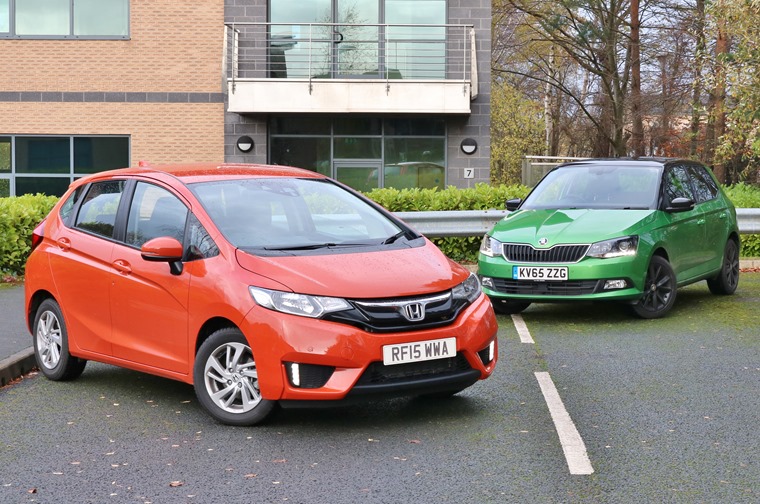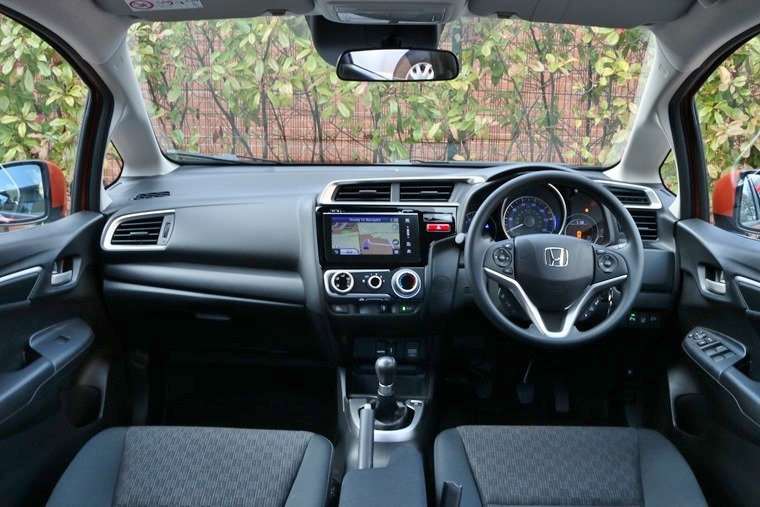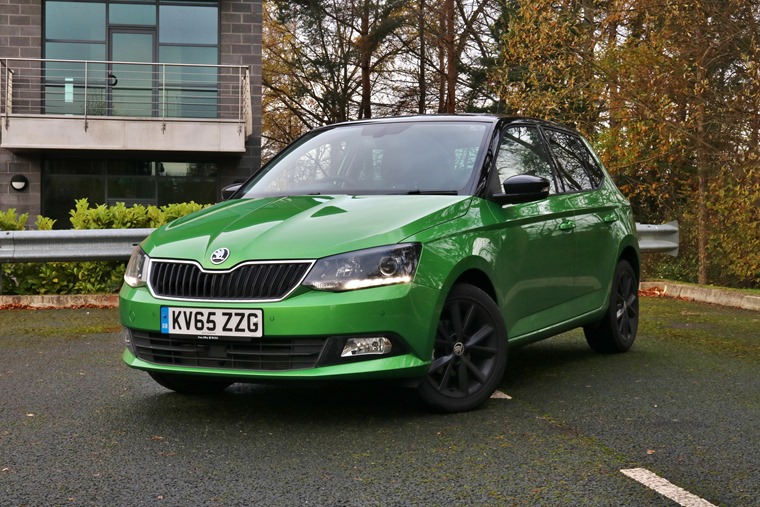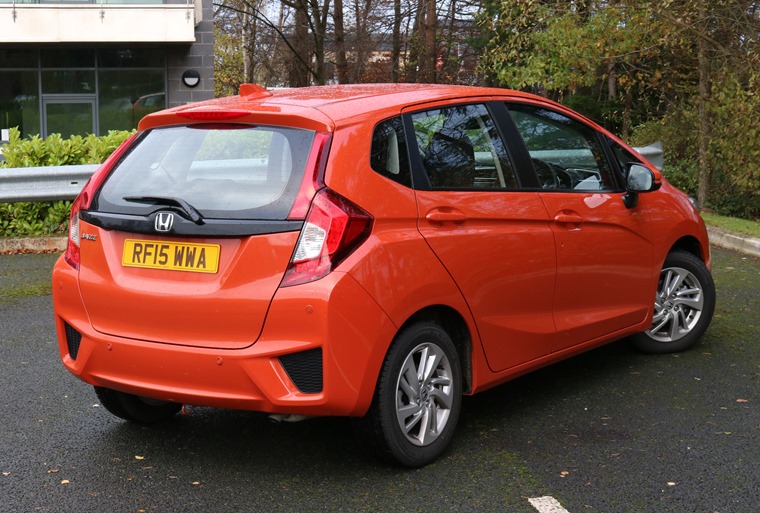Practicality matters: Honda Jazz vs Skoda Fabia
Skoda was very proud of its new Fabia when it was launched 12 months ago, claiming that its 330-litre boot put it up there with the most practical in the segment. Soon after, however, Honda came to spoil the party. A new Jazz was announced, boasting a cavernous 354-litre luggage bay and the dubiously named ‘Magic Seats’.
Clearly, a massive showdown was in order, so we gathered the two together to see which is best.

See all our leasing deals here:
Honda Jazz: business / personal
Skoda Fabia: business / personal
Exterior
The Jazz was arguably in less need of an aesthetic refresh than the Skoda, so it’s no surprise to see a broadly similar theme from the Honda. It has taken a slightly boxier, chunkier shape, but it’s still much the same silhouette as before.
However, we aren’t great fans of some of the fiddly details and though it’s fussy in parts, other areas are simply dull, featureless expanses of metal.
In contrast, we wholly approve of the Fabia’s update. It’s lower and wider than its predecessor and sharp lines give it a modern, crisp look.
Interior
If you value practicality to the exclusion of all other things, read no further – the Jazz is the car for you.
That boot is 24 litres larger than that of the Skoda, and the Magic Seats may sound like the invention of a schoolteacher desperately seeking order, but they do actually work.
The idea is that you can lift the seat squabs to provide a handy storage location for tall items that are best stored upright – something Honda demonstrated with a yucca plant – but we found them more useful for normal-sized delicate items that you don’t want flying around in the enormous boot.
It isn’t just luggage space that’s impressive about the Jazz though. There’s more legroom in the back than there is in a Mercedes S-Class, and little storage solutions like the cupholder beside the wheel come in more useful than you might expect.

Read our first drive review of the Honda Jazz here
The Skoda isn’t without its merits, mind you. Like the Honda, it’s only offered in useful five-door guise, while the Simply Clever additions, which include the ice scraper in the fuel filler cap and a door-mounted dustbin, are natty features.
A passionate Fabia owner might also argue that a 24-litre shortfall in boot capacity isn’t that noticeable, and you’d be surprised how much justification there is in that statement. Certainly, nobody is going to call the Skoda’s boot pokey.
Where the Skoda really differentiates itself, though, is in the build quality. Of course, cars that cost £13,000 do not have super-luxurious cabins and the Fabia is no exception, featuring hard plastics left, right and centre. The way Skoda has fitted those plastics together, however, is exemplary.
On the road
If you were expecting the Jazz to be a dull drive, think again. It isn’t fast, with its 101bhp 1.3-litre engine taking it to 62mph in a lethargic 11.3 seconds, but it actually handles quite well thanks to controlled body roll and a chassis designed specifically to improve turn-in. It works, and the Honda makes an agile and enjoyable B-road companion.
It’s less enjoyable when you hit a pothole though, because the stiff springs that prove so useful on a winding road are actually a touch too firm for the haggard highways of Britain.
Ride comfort is not the only refinement issue affecting the Jazz, though. The bluff front end means wind noise is noticeable at speed, while the engine’s drone seeps into the cabin constantly, making it quite a tiring car to drive.

Read our first drive review of the Skoda Fabia here
The Skoda is far more hushed, and though there is a bit of tyre roar when you get up to motorway cruising speeds, it’s much more relaxing. When you slow, however, you’ll spot the so-so low-speed ride that makes harsh speed bumps and potholed town centres deeply unappealing.
It isn’t even like the Fabia can claim this is a trade-off for stunning driving dynamics, because this new model is actually less fun than its chuckable little predecessor. Admittedly, we haven’t yet tried the Monte Carlo version with its sports suspension, but thanks to the feel-free electromechanical power steering system, the standard Fabia is pretty vague through the bends.
Running costs
It’s quite difficult to compare the Fabia and Jazz in terms of fuel economy because the Honda is a one-engine model. You’re stuck with the 1.3-litre petrol whether you like it or not, so if you want the long-distance economy of a diesel, you’re going to have to have the Skoda.
There is a comparable engine, however, and that’s the 1.2-litre 89bhp petrol found in our test car. Its 10.9-second 0-62mph time is similar to that of the Jazz, but the 60.1mpg economy is streets ahead of the Honda’s 55.4mpg thirst.
That said, our mid-range EX-spec Jazz was not the most economical variant, and opting for the S model with the CVT automatic transmission gets you a quoted efficiency figure of 61.4mpg and 106g/km CO2 emissions, which marginally undercut the 107g/km Skoda.

Check out the competition – you might want to consider one of these:
Volkswagen Polo / Hyundai i20 / Seat Ibiza / Kia Rio / Toyota Yaris / Alfa Romeo MiTo / Peugeot 208
It’s an even fight in terms of price too, because though Fabias start from £10,600, compared to the Jazz’s £13,495 base price, mid-range models are more closely matched.
When you look at lease rates, however, the gap widens. A mid-range Fabia averages £150 a month on typical three-year personal deals, but the equivalent Jazz comes in at around £50 a month more. It’s a similar story for business leases, although the gap is more like £40.
The verdict
It’s a crying shame that the Jazz is so badly let down by its engine and so-so lease rates, because it’s actually a fairly competent little car. It handles well and it’s incredibly roomy, but the accomplished Fabia is simply a far better all-round package.